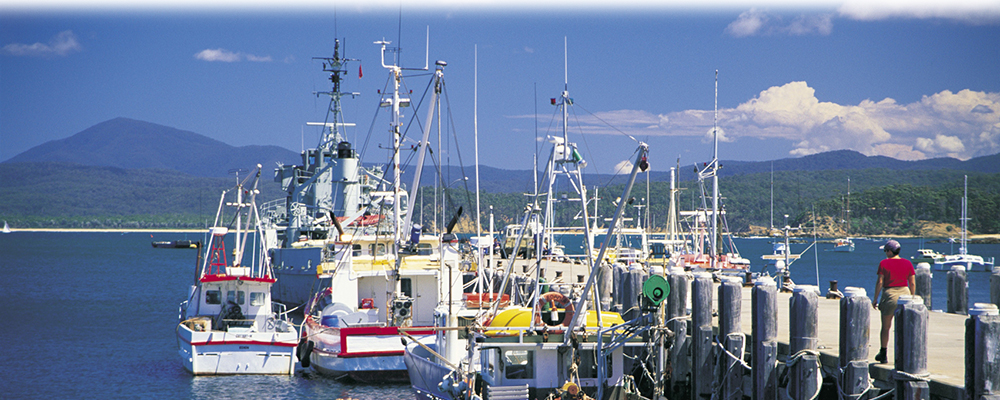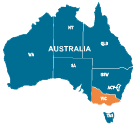Eden Local Fishing Information
| Fish Species | Best Baits To Use |
| River Blackfish: | Worms, Mudeyes, Beetles, Crickets. |
| Brown Trout: | Worms, Lures, Flies, Shrimp, Mudeyes, Grasshoppers. |
| Estuary Perch: | Minnows, Shrimp, Bass Yabbies, Lures. Bream best baits Sandworm, Bass Yabbies, Crab, Shrimp. |
| Whiting: | Clams, Mussels, Bass Yabbies. |
| Flathead: | Clams, Whitebait, Pilchards, Fish Fillets, Lures and Flies. |
| Snapper: | Bonito, Pilchards, Squid, Fresh Fish Fillets. |
| Gummy Shark: | Same as snapper. |
| Garfish: | Sandworms, Clams, Maggots. |
| Silver Trevally: | Whitebait, Clams, Squid, Fish Fillets, Bass Yabbies, Pilchards. |
| Australian Salmon: | Whitebait, Pilchards, Lures. |
| Yellow Kingfish: | Fresh Squid Trolled, Live Fish, Lures. |
| Snook: | Lures, Pilchards or Garfish rigged on gang hooks. |
The best bait in most cases is the natural food of the fish, so if you can pump or buy fresh bait, do so you will not be disappointed. Surf fishermen Pilchards white or blue bait and oil based fillets of fish like Bonito will usually land a fish ot two.
Tide times are usually available free in all stockists of fishing gear and are also usually found in the local papers.
Before fishing be aware of the bag and size limits of the various species and what licenses, if any are required.
Whiting:
![]() Both King George and Eastern School whiting are found throughout the coast.
Both King George and Eastern School whiting are found throughout the coast.
King George are caught both within the inlets and in deep water, (up to 20m) off shore. Light line is preferred; weight of tackle used for whiting depends on the depth of water being fished and the strength of the tidal stream.
Baits used include bass yabbies (nippers), pipis, cockles, mussels, worms, squid and small fillets of pilchard or other small fish. Squid is excellent for big whiting but should be cut into thin strips and pounded with a meat tenderiser to break up the fibres.
Snapper:
 Are taken both offshore and inside the inlets over a wide size range. Although heavy tackle is still used by some anglers, it is not necessary. However when using lines as light as 6kg it is recommended using a heavier leader of say 15kg breaking strain. Running sinker rigs are usually favoured for snapper when fishing in water shallower than 20 metres, and where the bottom is reasonably clean. Suitable sinker patterns are ball, bean, barrel and pyramid in weights from 25g to 150g depending on depth of water and strength of tidal stream.
Are taken both offshore and inside the inlets over a wide size range. Although heavy tackle is still used by some anglers, it is not necessary. However when using lines as light as 6kg it is recommended using a heavier leader of say 15kg breaking strain. Running sinker rigs are usually favoured for snapper when fishing in water shallower than 20 metres, and where the bottom is reasonably clean. Suitable sinker patterns are ball, bean, barrel and pyramid in weights from 25g to 150g depending on depth of water and strength of tidal stream.
A most effective leader for snapper fishing can be made from approximately 75cm of 15kg monofilament with solid brass ring or swivel tied to one end and a hook tied to the other. A second hook sliding on the line is an advantage and is placed in the bait as well giving increased hook cover. Size 4 hooks are preferred.
Flathead:
 The largest flathead inhabit the shallowest of water and the deeper waters and channels produce the smallest specimens or channel rats.
The largest flathead inhabit the shallowest of water and the deeper waters and channels produce the smallest specimens or channel rats.
In deep water, the most effective technique of flathead fishing is to allow the boat to drift with the wind or tide so that the sinker bumps along the bottom. Whether drifting or fishing at anchor, the rig remains the same. The sinker, usually a bomb pattern, is tied to the end of the line. Its weight is dependent on the tidal stream and depth of water, with the hook on a short dropper at least half a metre above the sinker.
Flathead will take whitebait, pilchards and fillets cut from any fresh fish. Live mullet also make good flathead bait. Lures are also reasonably successful.
Garfish:
![]() Sea garfish are abundant in all South Gippsland tidal lagoons where they feed on algae and other vegetable organisms. However, they are more than happy in include sandworm, maggots, tiny slivers of fish and pipi flesh in their diet. Although usually taken on a small hook, certainly no bigger than a No. 4, fished under a float, the biggest specimens are often encountered while fishing on the bottom for whiting.
Sea garfish are abundant in all South Gippsland tidal lagoons where they feed on algae and other vegetable organisms. However, they are more than happy in include sandworm, maggots, tiny slivers of fish and pipi flesh in their diet. Although usually taken on a small hook, certainly no bigger than a No. 4, fished under a float, the biggest specimens are often encountered while fishing on the bottom for whiting.
Garfish respond well to berley and can be attracted by anchoring in shallow water and beginning a berley trail of bread, pollard, layer's pellets or bran.
The best areas for garfish seem to be quiet sheltered corners of inlets in less than 3m of water.
Silver Trevally:
Are common throughout South Gippsland. Larger specimens seem to be found offshore around the island groups, while juveniles are abundant in coastal inlets to the limit of tidal influence.
Silver Trevally will accept a wide variety of baits including whitebait, pieces of pilchard, all shellfish like pipis and mussels as well as bass yabbies and craytail.
Yellow-eye Mullet:
There are at least two species of mullet found in the inlets of South Gippsland, sea mullet and yellow-eye mullet, but only yellow-eye mullet are caught in significant numbers by anglers.
While yellow-eye mullet will take a variety of baits but seem to prefer soft baits like worms, prawns, pipis and craytail. However, larger specimens will take whitebait. Light line no heavier than 3kg breaking strain, and small hooks around size 8 are preferred for mullet because they are gentle biters with small mouths.
Australian Salmon:
 Are the most prolific sport and table fish in South Gippsland. They are caught from all beaches by surf fishing enthusiasts, but the biggest catches by far are made by anglers trolling lures in the tidal stream from coastal lagoons like Shallow Inlet, Andersons Inlet and any of the other inlets of the Corner Basin.
Are the most prolific sport and table fish in South Gippsland. They are caught from all beaches by surf fishing enthusiasts, but the biggest catches by far are made by anglers trolling lures in the tidal stream from coastal lagoons like Shallow Inlet, Andersons Inlet and any of the other inlets of the Corner Basin.
Salmon will take both baits like whitebait and pilchards and lures like Juro Shiner, Wonder Pilchard and Halco Javlin, the weight of the lure depending on the tackle being used. It is recommended lures weighing 15g with light casting tackle.
Fishing Laws and Regulations:
When intending to fish any water, whether it be freshwater, estuary or saltwater, a vital part of the preparation should include seeking the relevant requirements and fishing laws pertaining to that water. All anglers should obtain a copy of the current 'Victorian Recreational Fishing Guide' which is available free at all Conservation and Natural Resources Offices and most fishing outlets.

Find accommodation on the Victorian Coast www.coastalstays.com:



